Login
Users can log into ProcessMaker from a standard web browser by entering the IP address of the server where ProcessMaker is installed:
-
http://<IP-ADDRESS>:<PORT>
If only the IP address (or domain name) is included in the URL, the web browser will automatically redirect to the ProcessMaker login screen at:
-
http://<IP-ADDRESS>:<PORT>/sys/en/neoclassic/login/login.html
If not running ProcessMaker from the default port 80, also specify the port number. For instance, if running ProcessMaker at the IP address 192.168.1.110 from the port 3018, then enter:
-
http://192.168.1.110:3018
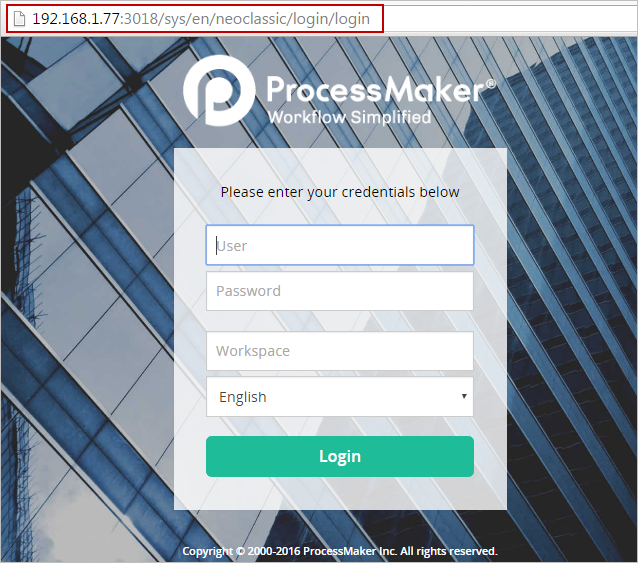
Enter a username and password. If the workspace was not included in the URL, also select the workspace, which by default is "workflow". The language can also be selected, if additional languages have been installed.
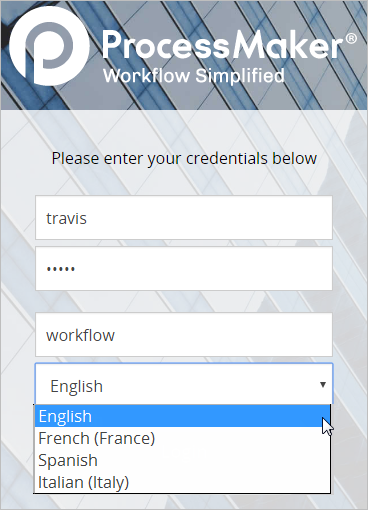
If ProcessMaker was just installed and logging in for the first time, enter the following credentials to login as the administrator:
- User: admin
- Password: admin
- Workspace: workflow
Once logged in as the "admin" user, create new users in ProcessMaker. During your first login, be sure to change the admin's password for greater security. Once users have been created, they will be able to login with their own usernames and passwords.
Login Settings
Note: From version 3.0.1.8. on, users must have the PM_SETUP_LOGIN permission assigned to their role to access the ADMIN > Settings > Login option.
To configure the Login Settings, go to ADMIN > Settings > Login
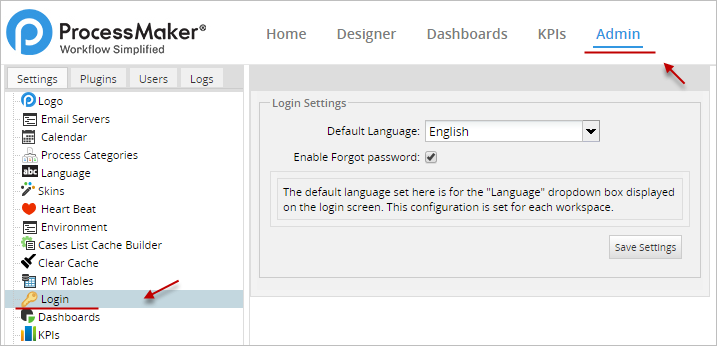
Default Language
This option lets the user select the language by default. This language is the one selected by default in the login screen. ProcessMaker is available by default only in English, but translation files for additional languages can be installed. This configuration is set for each workspace.
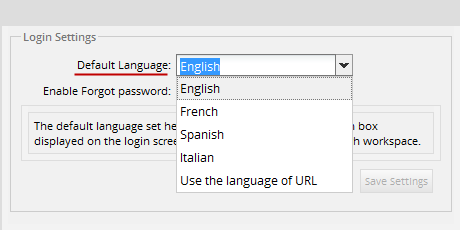
Forgotten Password
By enabling this option, if a user forgets the password to login to ProcessMaker, a link is displayed in the login screen to send a new randomly-generated password to their email account.
To enable users to get new passwords, mark the option Enable Forgot Password. Then, click on Save Settings.
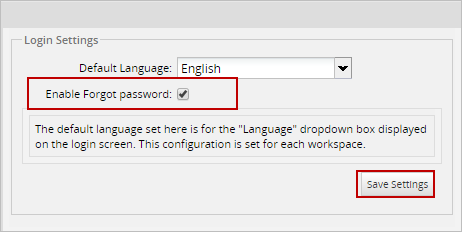
The next time a user logs into ProcessMaker, the Forgot Password link will be displayed in the login screen.
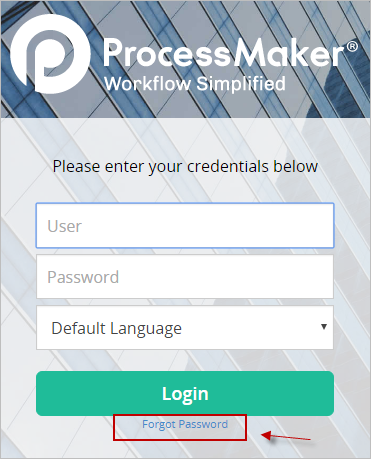
By clicking on Forgot Password, a new form will display:
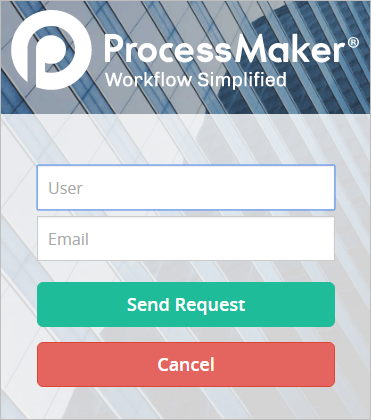
Where:
- User: Enter the username of the user who wants to login into ProcessMaker.
- Email: Enter that email address of the user where a new password will be sent.
If the username and email address match the record of a ProcessMaker user, then an email will be sent to that user with a new randomly-generated password.
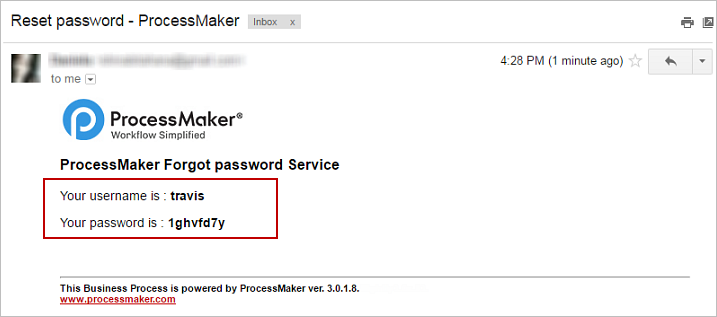
Note: To receive the email sent by the Forgot Password option, first ProcessMaker must be configured to connect to an email server. If it is not, a warning message will be displayed.

Enter the username and the randomly-generated password given on the email, and the following screen will display to reset the user's password.
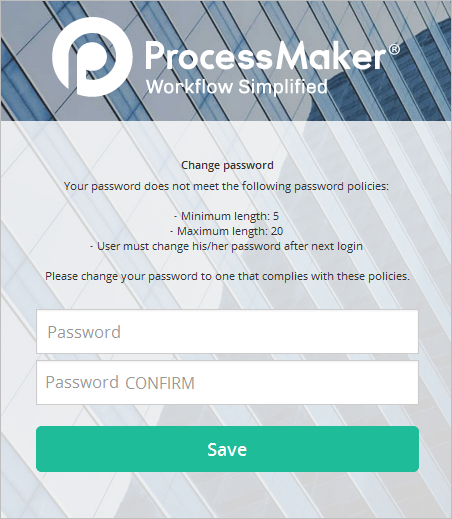
Changing the Destination after Login
After logging in, users with the PROCESSMAKER_OPERATOR and the PROCESSMAKER_MANAGER roles are directed by default to the HOME menu in order to displays a list of the user's cases, which is located at the address:
http://<IP-ADDRESS:<PORT>/sys<WORKSPACE>/<LANGUAGE>/<SKIN>/cases/main
Users with the PROCESSMAKER_ADMIN role or the PM_FACTORY permission in their role are directed by default to the DESIGNER menu after logging in, which is located at the address:
http://<IP-ADDRESS:<PORT>/sys<WORKSPACE>/<LANGUAGE>/<SKIN>/processes/main
Each user who has the PM_EDITPERSONALINFO permission in his/her role can customize where ProcessMaker directs the web browser after login. After logging in, click on the username in parenthesis in the upper right-hand corner to see the user's profile.

Then click on the Edit link in the bottom right-hand corner to change that profile.

In the Preferences section, select which menu should be default menu in the Default Main Menu Option dropdown box. Under the HOME menu, the list of cases in the Inbox are displayed by default. To change which option is selected by default in the Cases sidebar, select from the Default Cases Menu Option dropdown box.

The destination after login can also be changed by specifying the address of the next screen in the login URL:
http://<IP-ADDRESS:<PORT>/sys<WORKSPACE>/<LANGUAGE>/<SKIN>/login/login?u=<NEXT-ADDRESS>
Do not include the IP address in
For example, if wanting to go directly to the ADMIN menu after login to the ProcessMaker server in the example above:
http://192.168.1.50/sysaccounting/fr/company/login/login.html?u=/sysaccounting/fr/company/setup/main
Login Records
Every time a user logins to ProcessMaker, a record is kept in the wf_<WORKSPACE>.LOGIN_LOG table in the database, which contains the following fields:
| Name | Description |
|---|---|
| LOG_UID | A unique ID to identify the login session. |
| LOG_STATUS | The status of the login session which can be "ACTIVE" or "CLOSED". If set to "CLOSED", the user ended the login session by clicking on Logout. If set to "ACTIVE", the login session may still be open, but it also might have expired due to inactivity. |
| LOG_IP | The IP address of the user's computer. If logging in on the same computer where ProcessMaker is installed, then this will be set to "127.0.0.1". |
| LOG_SID | The session ID that PHP uses to uniquely identify the session. It is 26 characters long and consists of lowercase letters and numbers. | LOG_INIT_DATE | The datetime when the login session started in "YYYY-MM-DD HH:MM:SS" format. | LOG_END_DATE | The datetime when the login session was closed in "YYYY-MM-DD HH:MM:SS" format. This field will only be set if the user clicks on the Logout link. If the login session is still open or it has expired due to inactivity, then it will be set to NULL. | LOG_CLIENT_HOSTNAME | The IP address (and port number) of the ProcessMaker server. format. | USR_UID | The unique ID of the user who logged in. |
If needing to generate reports about user logins, the wf_<WORKSPACE>.LOGIN_LOG table can be queried with SQL in DynaForm fields, executeQuery() in Triggers, or external reporting tools, such as Jasper Reports, Pentaho Reporting, Crystal Reports, etc.



